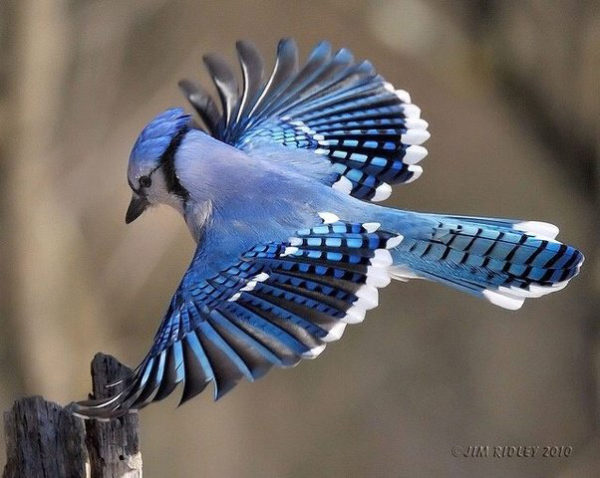Information About The Bird
Seen/Heard at
Decorah, Decorah North, Great Spirit Bluff
Diet
Look for Blue Jays where the food is. During the summer, Blue Jays eat large numbers of invertebrates, searching for beetles, snails, and grasshoppers on the ground in the morning and moving higher into trees as the day warms and insects rise. Blue Jays also forage for nuts, including acorns and beech nuts; dried and fresh fruit, including cedar berries, juniper berries, hackberry, service berry, chokecherries, hawthorn, dogwood, and sumac fruits, seeds, grain, the eggs of other birds, and occasionally small rodents, frogs, nestlings, and carrion. We sometimes see them searching for scraps in our eagle nests and we often find their remains in our falcon nests.
Blue Jays are long-term food cachers with gular pouches that help them carry up to five acorns at a time. How many acorns can a Blue Jay cache? Researchers studying blue jay caching behavior observed 50 jays transport roughly 150,000 acorns in just 28 days. You can learn more about blue jay caching here: https://www.kcchronicle.com/2016/10/31/good-natured-blue-jays-and-the-gular-pouch/aofwbls/.
Nesting
Blue Jays nest from late March through late August. Males and females build cup-shaped, rootlet-lined nests of twigs, grass, and mud in the crotches or stout branches of trees. On average, males do more gathering and females do more building, although the percentage varies from population to population. Blue Jays lay 2-7 bluish eggs spotted with brown and produce one to two clutches per year. Females incubate eggs for 17-18 days and both parents tend young, which leave the nest 17-21 days after hatching. To learn more, visit Cornell’s website.
Citations
Bird Range Maps of North America
Ridgely, R.S., T.F. Allnutt, T. Brooks, D.K. McNicol, D.W. Mehlman, B.E. Young, and J.R. Zook. 2003.
Digital Distribution Maps of the Birds of the Western Hemisphere, version 1.0. NatureServe, Arlington, Virginia, USA. Data provided by NatureServe in collaboration with Robert Ridgely, James Zook, The Nature Conservancy – Migratory Bird Program, Conservation International – CABS, World Wildlife Fund – US, and Environment Canada – WILDSPACE.
Web Link: http://bit.ly/2ynPQ5I
Birds of North America: https://birdsna.org/Species-Account/bna/species/blujay/introduction
Photo credit Jim Ridley 2010
General Description
Blue Jays have white to light grey underparts and flashy blue overparts. Their blue wings and tails are barred black and may be tipped white, creating a stained glass-like appearance. Blue Jays have prominent blue crests and bold black necklaces.
Blue Jays imitate hawks! I’ve often seen our yard jays scatter other birds from the bird feeder with their hawk calls, but I’ve also seen them imitating hawks with no apparent purpose in mind. You can learn more about bird mimics here (Blue Jays are at the bottom of the page): https://www.audubon.org/news/are-you-listening-bird-mimic-or-real-deal.
Migration
Blue Jays live in the Decorah area year-round.
Measurements
Length: 9.8-11.8 in/25-30 cm
Wingspan: 13.4-16.9 in/34-43 cm
Weight: 2.5-3.5 oz/70-100 g
Wing Design
Elliptical. Optimized for bursts of fast, tightly controlled flight. Excellent at taking off quickly, maneuvering through branches, and avoiding predators.
| See also different: | Decorah Nest, Decorah North Nest, Great Spirit Bluff, Jays and Crows |
